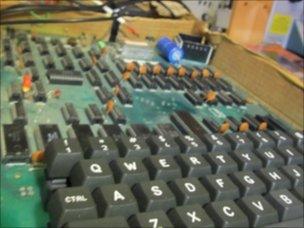Tech Know: Recreating the era of 8-bit computers
- Published
WATCH: Computer collector John Honniball shows Ellie Gibson how to recreate an 8-bit PC
Chances are that you are reading this article on a computer screen. Most would agree that a modern 32 or 64 bit machine is a pretty complicated piece of equipment.
While it is easy to buy the parts of a modern PC - motherboard, graphics card and processor - the sheer complexity would defeat any attempt to build one starting with electronic components such as resistors, capacitors and chips.
But what about earlier generations of computer? The technology that brought us the BBC Micro, Sinclair's ZX series and the Commodore 64 and Vic 20?
Is it still possible to construct an 8-bit machine from a pile of parts?
Bit parts
Programmer and "maker" Julian Skidmore has done just that with his creation of a novel 8-bit computer called the Fignition. Even better, his homebrew machine is designed to DIY. Anyone with a modicum of experience in electronics should be able to put it together.
His inspiration for the project was the work of the 8-bit pioneers, such as ZX80 hardware designer Jim Westwood, who created those much-loved machines almost entirely by themselves.
Curiously, said Mr Skidmore, designing an 8-bit computer using parts available today is arguably harder than it was in the 1980s.
"The sheer simplicity of the old circuits meant it was relatively easy to put together a set to make a computer," he said.
"Today most chips are highly sophisticated or dedicated to particular jobs," he added. "In either case they will use extremely fine pitch points."

The Compukit 101 computer was a formidable machine to build
For those that do not know, "pitch points" are the distance between the legs on a processor. If the legs are too fine then soldering them by hand becomes impossible. Which means goodbye DIY.
Mr Skidmore faced more problems once he had found the components.
"There's a massive difference between having the concept of how to design something and implementing it in real devices because you have to get all those devices to work together," he said.
"They can expect different voltages or different clock rates or have interfacing issues that makes it less obvious how to put them together to make a working machine."
He found a way round that by running a virtual machine on a microcontroller chip that directly generates its video output. It can be programmed via eight keys fixed on one side.
Build this
The BBC put his design to the test with the help of electronics wizard John Honniball.
There can be few better people to help with the job of building an 8-bit machine.
Mr Honniball still has the 8-bit Compukit 101 that he built from a circuit diagram published in the August-November issues of Practical Electronics magazine in 1979.
The interest in electronics sparked by that project still burns; Mr Honniball has now clocked up 31 years of experience, soldering components onto circuit boards.
His home is a treasure trove of old computers and test equipment. The latter, including oscilloscopes and multimeters are kept for "spiritual" reasons.
"Half of the stuff here is to frighten the circuit boards into working," said Mr Honniball. "They know the treatment they it will get if they do not work properly."

The Fignition 8-bit computer put together by Ellie Gibson and John Honniball
The difference between a pile of parts and a working computer is solder - the metal alloy used to connect components to circuit boards.
Mr Honniball has advice for those contemplating building a computer, or any other electronics kit, by soldering components.
"The soldering iron is not a spoon," he said. "You are not spooning the solder on to the connection."
"What we are trying to do is get thermal contact," he said. "You want to be bridging the copper track and the leg of the component."
A good joint means electricity flows when the device is powered.
Another piece of good advice is to start with the smaller components, such as resistors, that sit closest to the board. Putting the bigger pieces, like timing crystals and TV outputs, on first makes it hard to get those smaller components in place.
For Mr Honniball, the Fignition build was a breeze and took around an hour to complete.
There was nothing here to fox him or a novice.
"A beginner could do this, there's nothing particularly tricky," he said. "It's got a bit of meat to it but nothing difficult in terms of being hard to solder."
He admits that building your own computer to play simple games is a very long-winded way to go about it. But few could deny the joy to be had in switching it on for the first time and seeing the boot screen pop up.
Fignition creator Julian Skidmore said: "Building the machine is a way to learn the essentials of what a computer is all about."
And what self-respecting maker would not want to do that?
- Published1 March 2011
- Published3 February 2011
- Published7 December 2010
- Published28 October 2010